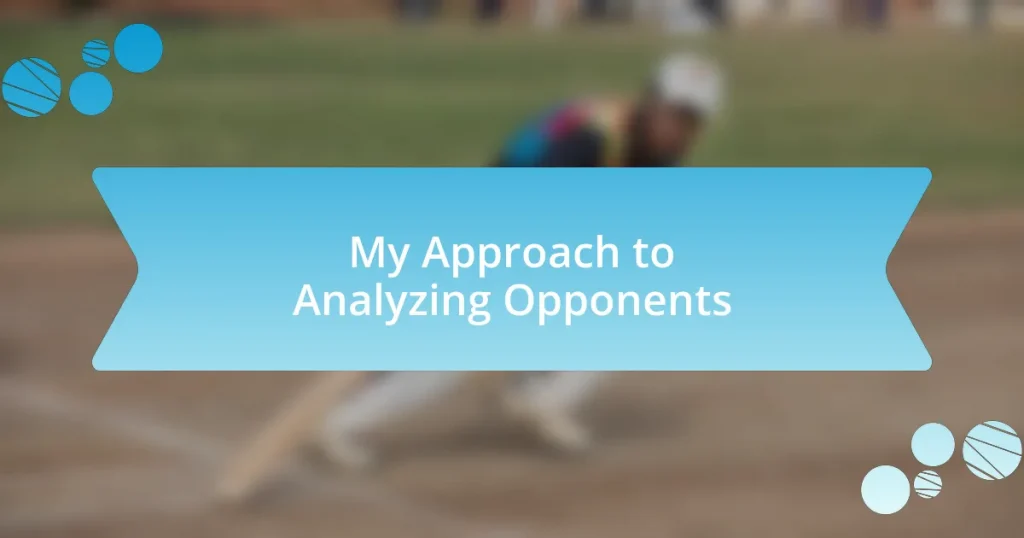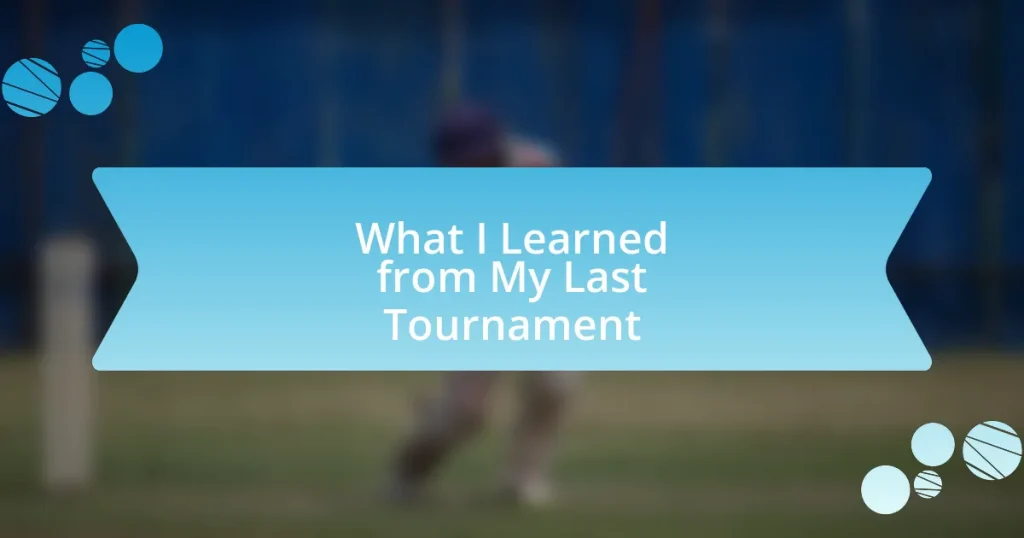Key takeaways:
- Opponent analysis involves understanding not just strengths and weaknesses but also psychological nuances and body language.
- Identifying key traits such as body language, emotional responses, and decision-making patterns is crucial for competitive strategy.
- Gathering diverse data sources, including statistics, social media insights, and peer discussions, enhances opponent analysis.
- Continuous improvement and adaptability are essential in formulating effective strategies and responding to in-game changes.

Understanding Opponent Analysis
Understanding opponent analysis is crucial in any competitive field. From my experience, this process isn’t just about identifying strengths and weaknesses; it’s about diving deeper into the mindset and strategies of your opponents. Have you ever watched a game unfold and realized how the best players anticipate their rivals’ next moves? This anticipation is key to crafting effective responses.
When I first started analyzing opponents, I focused solely on statistics and past performances, but I soon discovered that body language and tactics during a match tell just as much, if not more. I remember a specific match where I observed my opponent’s nervous gestures whenever I made specific moves. This insight changed how I interacted on the field, making me rethink my approach based on their behavior.
Many believe that opponent analysis is a one-time effort, but I’ve found that it’s an ongoing process. Have you ever seen how a team adapts its strategy mid-game? This adaptability often stems from continuous observation. By staying alert and responsive to my opponents, I’ve not only improved my game but also developed a deeper respect for the intricacies of competition.
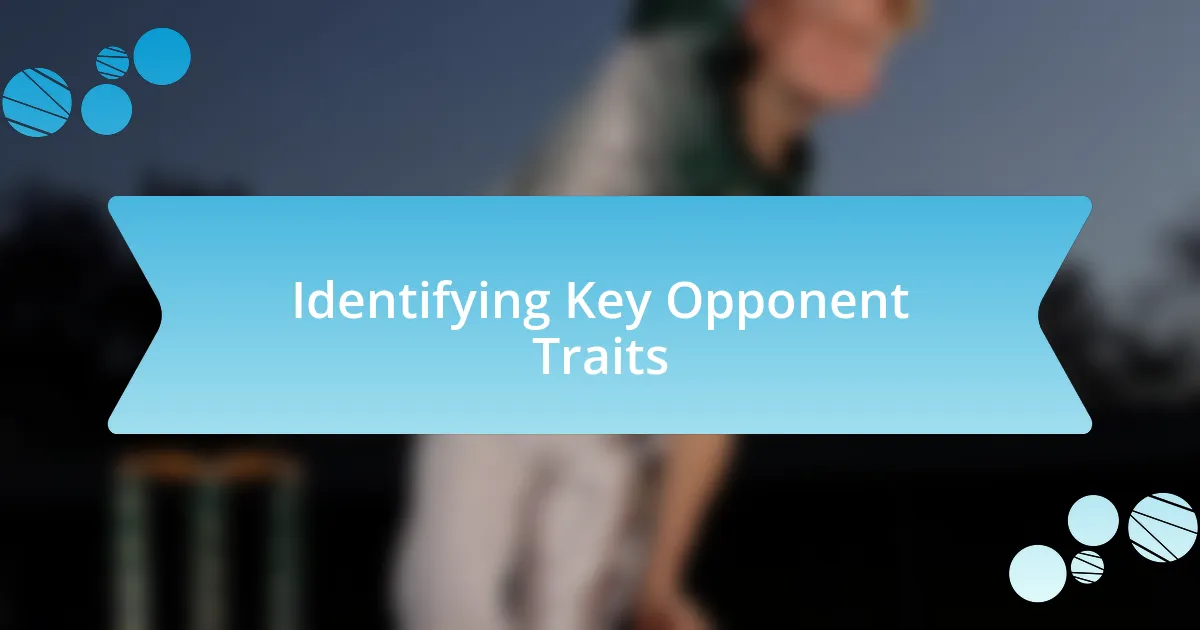
Identifying Key Opponent Traits
Identifying key traits in opponents is a vital step in any competitive analysis. I’ve learned that observing not just what they do, but how they do it can reveal critical insights. For example, I once faced a rival who always took a deep breath before serving. This small, seemingly innocuous action made me realize they relied heavily on routine for focus, which I could potentially disrupt with my own strategies.
When analyzing opponents, I focus on the following traits:
- Body Language: Are they confident or hesitant?
- Reaction to Pressure: How do they respond in high-stakes moments?
- Decision-Making Patterns: Do they favor specific plays or strategies?
- Consistency: Are they predictable, or do they mix things up?
- Emotional Responses: What visible emotions do they display during the game?
Recognizing these traits has transformed how I prepare for competition. On one occasion, I identified that my opponent became visibly frustrated when I played aggressively. Capitalizing on that emotion allowed me to shift my game plan and gain the upper hand.

Gathering Relevant Data Sources
Gathering relevant data sources is crucial for a thorough understanding of opponents. I’ve often turned to public statistics and match records, which provide a wealth of information about performance and habits. For instance, during my preparation for an important tournament, I pored over past matches and noticed a competitor struggled against left-handed players. This insight led me to tweak my strategy, enhancing my chances of success.
Another helpful source is social media and interviews, where I can catch glimpses of an opponent’s mindset and personal life. I remember one time, I read an interview where a rival expressed their fear of failure. This made me realize that when the pressure was on, a psychological advantage might tip the scales in my favor. Understanding their mental landscape is just as critical as analyzing their physical skills.
In addition, engaging with forums and sports analysts can bring new perspectives that traditional sources might overlook. I once stumbled onto a discussion that pointed out specific weaknesses in an opponent’s game, which I hadn’t considered. It prompted me to rethink my approach entirely. By exploring these varied sources, I can create a nuanced analysis that goes beyond surface-level facts.
| Data Source | Benefits |
|---|---|
| Public Statistics | Offers quantifiable insights into performance trends. |
| Social Media | Reveals psychological factors and personal motivations. |
| Analysts and Forums | Provides diverse viewpoints and potential strategies. |
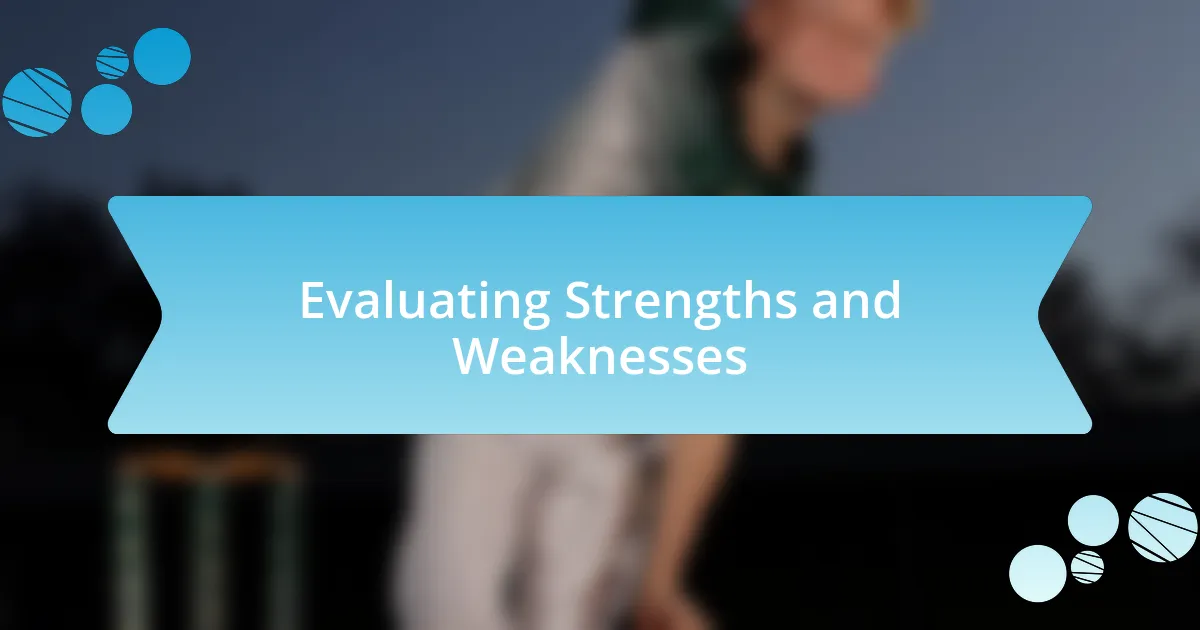
Evaluating Strengths and Weaknesses
Evaluating an opponent’s strengths and weaknesses requires a keen eye for detail and a willingness to dig deeper than the stats. I once faced a player known for their powerful serve. While they could dominate many matches, I discovered that their return game was inconsistent, especially under pressure. This kind of analysis can change how I approach a match and lead to game-changing strategies.
I find that emotional factors can also reveal weaknesses. Observing a rival’s body language during critical points often gives me clues about their mental state. For example, I remember watching an opponent fidget and lose focus as the stakes got higher. That moment convinced me that exploiting their anxiety could give me the upper hand, illustrating the importance of not only assessing physical skills but also psychological resilience.
Moreover, acknowledging an opponent’s strengths is just as vital. By recognizing what they excel at, I can tailor my tactics to neutralize their advantages. When I played against a competing athlete renowned for speed, I focused on slowing down the game. Asking myself, “How can I turn their strength into a vulnerability?” guided my planning and allowed me to devise a winning strategy. It’s fascinating how a thorough evaluation of both strengths and weaknesses leads to a more complete understanding of the opponent, ultimately paving the way for a more effective game plan.
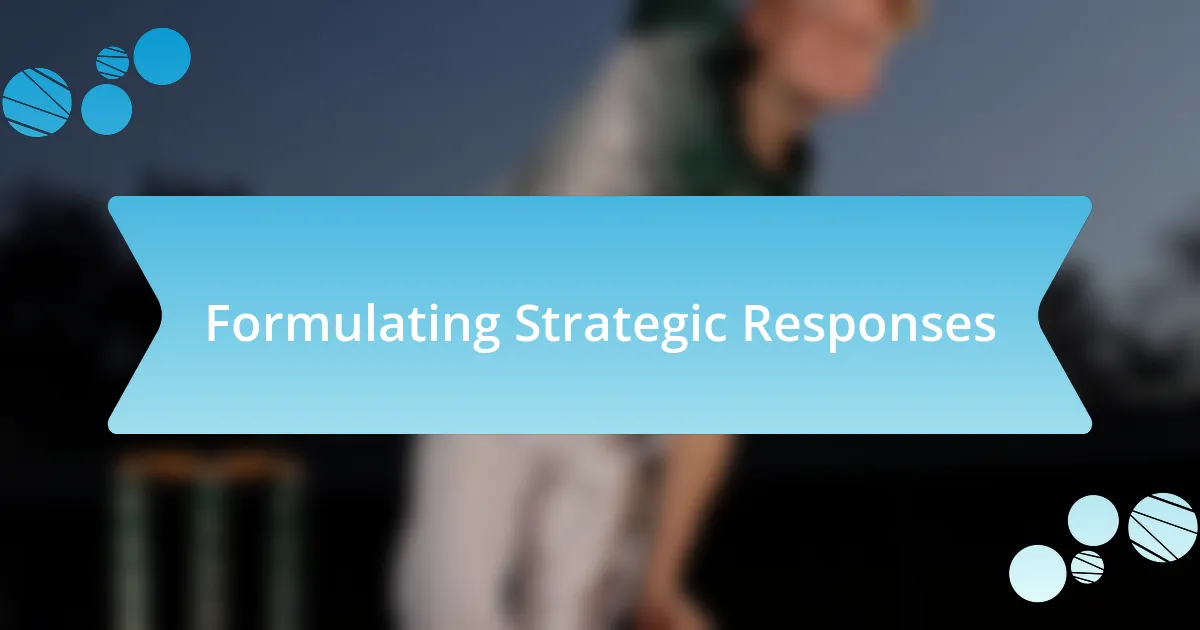
Formulating Strategic Responses
Formulating strategic responses is all about tailoring your game plan to exploit the intricacies of your opponent. In a recent match, I noticed a competitor who thrived in aggressive exchanges but faltered during long rallies. Instead of matching their intensity, I decided to adopt a more patient approach, drawing out points and forcing them into the uncomfortable territory of endurance. This shift in strategy not only kept me in control but also threw them off their rhythm.
Another practice I find effective is leveraging past encounters. I often reflect on my previous challenges against specific players to notice patterns. For instance, during a tournament, I recalled how one opposing player struggled with unorthodox shots. This insight led me to incorporate more varied spins and angles into my game, which ultimately disrupted their comfort zone. Isn’t it interesting how our past experiences can directly inform our present strategies?
I also believe in the power of adaptability during a match. Sometimes, what works on paper doesn’t translate on the court. I recall a time when I adjusted my approach mid-game after realizing my opponent was more agile than anticipated. I shifted to a more defensive playstyle, focusing on positioning and placement instead of sheer power. This adaptability not only saved me from potential defeat but taught me that flexibility can often turn the tide in unexpected ways. Doesn’t it feel empowering to adjust and thrive even when the odds seem against you?

Implementing Actionable Insights
Implementing actionable insights is about translating analysis into concrete steps that can make a difference in the moment. For example, I recall a match where I realized my opponent relied heavily on their backhand. Instead of just planning to avoid it, I actively sought opportunities to hit deeper forehands, forcing them out of their comfort zone. This adjustment not only gave me the upper hand but also made me feel like I was truly in the driver’s seat of the match.
When I think about adjustments, I remember a time when I was facing a particularly quick player who thrived on pace. In that moment, I made a mental checklist of every time they struggled with slower balls. This realization motivated me to intentionally play a few slices, allowing me to control the tempo and take them by surprise. Doesn’t it make you think about how much knowing an opponent can change how we approach our own game?
I also find that documenting my thoughts post-match can be immensely beneficial. Over the years, I’ve kept a journal detailing my observations and strategies that worked or didn’t during my matches. Looking back at these notes not only aids my preparation but also builds my confidence—like a library of experiences I can draw from anytime I need it. Have you ever considered how your reflections could provide clarity in future scenarios?
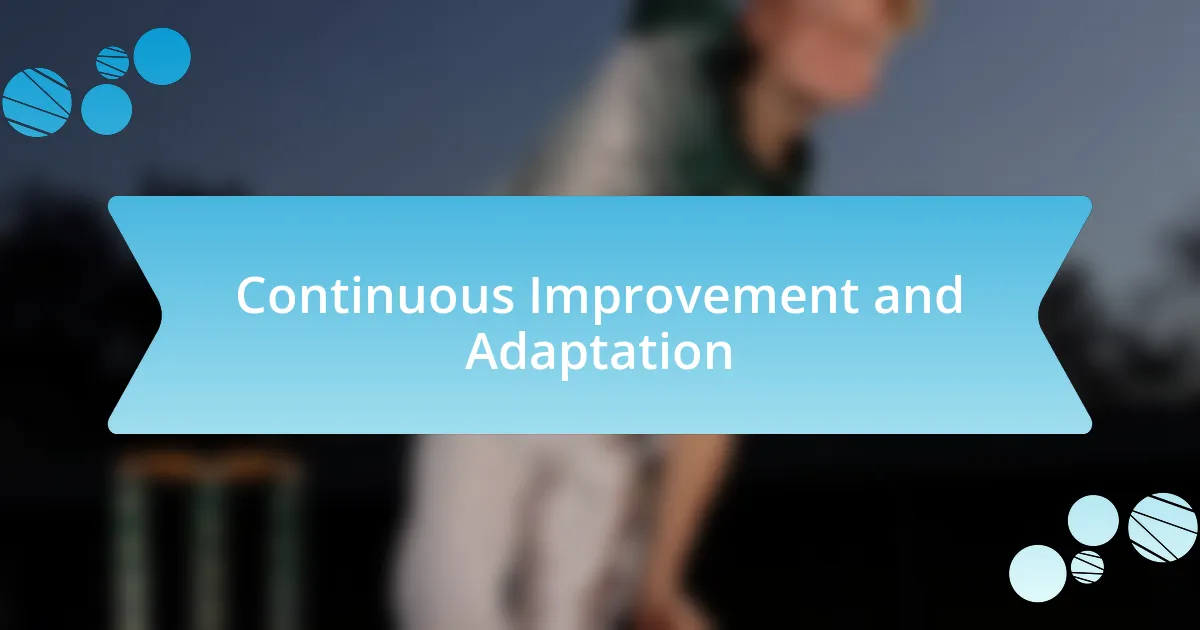
Continuous Improvement and Adaptation
Continuous improvement is a cornerstone of my approach to analyzing opponents. I remember the anxiety I felt before a crucial match against an unpredictable rival. Instead of letting that pressure overwhelm me, I used it as motivation to study previous games, identifying patterns and weaknesses I could exploit. This proactive mindset transformed my fear into a strategic advantage.
Adaptation is not just about recognizing the need for change; it’s also about executing it effectively. I once faced an opponent who shifted tactics mid-game, disrupting my rhythm. In that moment, I had to quickly rethink my strategy, focusing on playing more defensively and patiently waiting for openings. This swift adjustment taught me that flexibility is vital, not just in matches but in all competitive scenarios.
I often ponder how my mindset has evolved over time. Early in my career, I was hesitant to make in-game adjustments, fearing I’d lose my initial strategy. However, as I’ve matured, I’ve learned that successful athletes aren’t just reactive; they’re proactive, constantly fine-tuning their approach. Have you thought about how your ability to adapt could elevate your own performance? Each match offers a unique opportunity for growth, if only we remain open to it.










